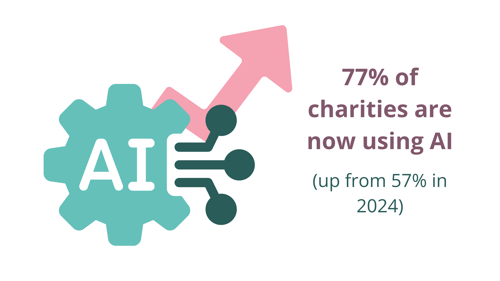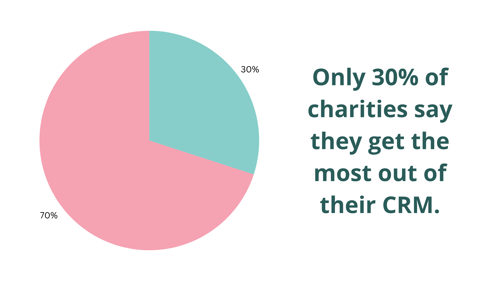How fundraising has been evolving in 2025: what UK charities need to know
The fundraising landscape is shifting beneath our feet, and if you're feeling like you're constantly playing catch-up, you're not alone.
The good news? Despite the economic doom and gloom, many charities are actually doing better than they think. The challenging news? The gap between digitally savvy charities and those struggling with technology is widening - and it's starting to show in fundraising results.
The economic challenge that’s reshaping everything
Let's start with the elephant in the room.
In a recent report, “The Status of UK Fundraising 2025”, a staggering 84% of fundraisers cited the current economic landscape as their biggest challenge.
Up from previous years, and probably little surprise to many. But here's what's interesting: while everyone's (rightly) wary about the economy, 64% of respondents actually met their fundraising targets last year, and 46% saw their income grow.
What's separating the charities that are thriving from those that are struggling? It comes down to three key factors that are defining fundraising success so far in 2025.
The relationship revenue revolution
The biggest shift is a return to relationship-based fundraising, but with a more modern twist. Charities that experienced income growth overwhelmingly point to one factor: exceptional gifts. Nearly half (48%) of growing charities attribute their success to exceptional gifts, and this isn't about luck.
Exceptional gifts are rarely random windfalls - they're the result of deliberate donor management strategies. The charities seeing growth are those investing time in understanding their supporters, building genuine relationships and creating donor journeys that turn one-off givers into long-term supporters.
What's particularly telling is that organisations focusing on supporter experience (32% of growing charities) are seeing real returns. This highlights how it's not enough to simply ask for money; supporters want to feel genuinely connected to your cause and impact.
The great income diversification
Here's a stat that should make every fundraiser pause: while government grants are crucial for those who receive them (28% rank them as their top income source), over-reliance on any single stream is becoming risky business.
The charities that are thriving in 2025 have cracked the diversification code. They're seeing growth in individual giving, major donors and foundation grants, while reducing their dependency on government funding. It's not that government grants are bad, it's that putting all your eggs in one basket is increasingly risky in a volatile economic climate.
Small charities, in particular, are leading the way here. Relying primarily on grants, they've had to become experts at building diverse, resilient income portfolios.
The AI adoption boom (and why it matters for your data)
Perhaps the most dramatic shift has been the explosion in AI adoption.

We've jumped from 57% of charities using AI in 2024, to 77% so far this year. But before you panic about being left behind, here's the reality: most organisations are still in the early stages.
The majority are using AI for content creation, like drafting newsletters, social media posts and reports. Only 11% say they’re using it for the really powerful stuff, like predicting donor behaviour or prospect research.
This presents a massive opportunity for forward-thinking fundraisers.
But here's the crucial insight: the organisations getting the most value from AI aren't necessarily the most tech-savvy - they're the ones with clean, well-organised data ...
The digital maturity divide
This brings us to perhaps the most important trend shaping fundraising in 2025: the growing divide between digitally mature organisations and those still struggling with basic technology adoption.
The research reveals something fascinating – digital maturity isn't about your size.
Small charities can be just as digitally sophisticated as large ones. What matters is having the right foundations in place.
Charities with above-average digital maturity are 43% more likely to drive growth through increasing donor numbers. They're also significantly more likely to say their charity CRM enables them to build stronger relationships and that they get the most out of their technology.

But here's the concerning part: only 30% of charities say they're getting the most out of their donor management system. That means 70% of charities are leaving money on the table, simply because they're not maximising their existing tools.
The foundation that makes everything else possible
What's becoming crystal clear is that none of things trends exist in isolation.
Whether it's building donor relationships, diversifying income streams or preparing for AI integration, everything comes back to having solid data management and the right technological foundation.
In fact, improved data management is the number one priority for 66% of organisations, followed by integrated technology solutions (54%) and training to use technology to its fullest potential (52%).
This isn't about having the flashiest new tech - it's about having joined-up systems that actually work for your team and your supporters. You should be able to track donor journeys, segment your communications effectively and spot opportunities for deeper engagement.
Turn supporter info into insight with Donorfy
What this means for your charity right now
So where does this leave you? If you're feeling overwhelmed by all these changes, start with the basics:
- Audit your data quality
The truth is: most charities start out with scattered, scary data. But, you can't build AI capabilities or sophisticated donor strategies on messy data. Clean data is a short and long-term win, and there’s some great advice here.
- Look beyond grants
If you're heavily reliant on government funding, now's the time to start diversifying. Individual giving and major donor programs are showing real growth potential.
- Invest in relationships, not just transactions
The charities thriving in 2025 understand that fundraising is fundamentally about human connections – technology should enhance these relationships, not replace them.
- Get your team properly trained
The best charity CRM in the world won't help if your staff don't know how, or want to, use it effectively.
The tools that make a difference
None of this happens in a vacuum. The charities that are successfully navigating these changes share one common factor: they have donor management systems that actually support their ambitions, rather than holding them back.
This is where choosing the right technology partner becomes crucial. You need a system that's intuitive enough for your whole team to use effectively, powerful enough to grow with you, and modern enough to integrate with the tools that already use - or want to.
At Donorfy, we've designed our CRM specifically for UK charities navigating exactly these challenges. Whether you're a small organisation looking to diversify your income streams or a growing charity preparing for AI integration, we help provide the clean, organised foundation that makes everything else possible.
You don’t have to take a shot in the dark, either. You can get a feel for the benefits, in your own time, by starting a free trial of Donorfy today.
The bottom line
Fundraising in 2025 isn't about choosing between old-school relationship building and new-school technology.
Charities are utilising modern tools to do what they’ve always done best - connect with people who care about their causes, and help them make a meaningful impact.
The organisations that are thriving aren't necessarily the biggest or best-funded. They're the ones that have invested in getting the basics right: clean data, strong relationships, diverse income streams, and teams that are on board with using the right tools.
And the question isn't whether your organisation can adapt to the 2025-way, it's whether you'll lead the way or play catch-up.
The foundation you build today will determine which side of the digital divide you'll be on in 2026.
FAQs
Our charity is doing fine with our current systems. Do we really need to worry about these trends?
Not necessarily, change isn’t always necessary. Still, while "fine" might feel comfortable now, the data shows that charities that aren’t adapting are increasingly falling behind.
With 70% of charities not maximising their current systems and the digital divide widening, staying static can mean going backwards.
The key is starting with small improvements rather than complete overhauls.
You can chat to our experts about your technology options, just get in touch.
We're a small charity with limited resources. How can we compete with larger organisations using AI and advanced technology?
Good news, digital maturity isn't necessarily about size or budget. Small charities can be just as digitally sophisticated as large ones!
Start with the basics: clean data, good training and choosing tools designed for charities - like Donorfy. Many of the most effective AI applications (like content creation) are accessible and affordable for charities of all sizes, too.
Should we be using AI if we're still struggling with basic data management?
Good question! AI is only as good as the data you feed it. Focus on getting your data house in order first.
If you’re using spreadsheets, getting it into a charity CRM is a great starting point. Clean, well-organised data will give you immediate benefits and create the foundation for AI adoption when you're ready.
How can we diversify our income streams without spreading our team too thin?
Start small and build systematically. Successful diversification often begins with strengthening individual giving and major donor programs – both of which build on relationship-building skills you already have. Choose one new stream, master it, then gradually add others. The right CRM can help you manage multiple income streams without multiplying your workload.
What if our trustees are resistant to investing in new technology?
Use the data to make your case. Explain how 43% of digitally mature organisations are more likely to drive growth through increased donor numbers, and that improved data management is the top priority for 66% of charities.
Ultimately, it’s risk management, as the cost of falling behind digitally often exceeds the investment in catching up.
How do we know if we're getting the most out of our current CRM?
Ask yourself: Can you easily track donor journeys? Segment supporters effectively? Generate insights about giving patterns? Is it helping you do your job?
If you're answering "not really" to these questions, you're likely in that 70% who aren't maximising their systems.
Accessing training if needed, and/or carry out an audit of your current capabilities versus your needs.
How quickly do we need to adapt to these changes?
The trends are accelerating, but panic not! Focus on building solid foundations rather than chasing every new development.
Organisations that invested in good data management and relationship-building capabilities are better positioned for AI adoption than those who jumped straight to advanced tools without the basics in place.

 AU & NZ
AU & NZ
 SG
SG
 MY
MY
 US
US
 IE
IE


